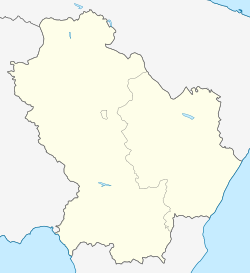Marsico Nuovo: Difference between revisions
LaaknorBot (talk | contribs) m robot Adding: ru:Марсико-Нуово |
J. A. Conroy (talk | contribs) mNo edit summary |
||
| Line 33: | Line 33: | ||
}} |
}} |
||
'''Marsico Nuovo''' is a town and ''[[comune]]'' of the [[province of Potenza]] in the [[Basilicata]] region of southern [[Italy]]. It was the seat of the |
'''Marsico Nuovo''' is a town and ''[[comune]]'' of the [[province of Potenza]] in the [[Basilicata]] region of southern [[Italy]]. It was the seat of the [[bishop]]s of [[Grumentum]]. |
||
==Geography== |
==Geography== |
||
| Line 39: | Line 39: | ||
==History== |
==History== |
||
The city's origins are obscure, but, after the destruction by the Saracens of the ancient ''Grumentum'', the town grew in importance, and became the seat of a county under the Normans (11th century). Its most famous count was [[Sylvester of Marsico]]. |
The city's origins are obscure, but, after the destruction by the [[Saracens]] of the ancient ''Grumentum'', the town grew in importance, and became the seat of a county under the [[Normans]] (11th century). Its most famous count was [[Sylvester of Marsico]]. |
||
It became an episcopal seat, when Bishop Grimaldo of Grumentum established his residence there, retaining, however, his former title. There were bishops of Grumentum as early as the sixth century: it is said that a Saint Laberius or Saverius first preached the Gospel there. Other bishops were Enrico (1131), who finished the cathedral; Blessed Reginaldo of Viperno, a Dominican (1275); Pietro (1329), several times papal legate; the friar Paolo Caselli (1614), who restored the cathedral. In 1818 the diocese was merged with that of Potenza.<ref>{{CathEncy|wstitle=Marsico Nuovo and Potenza}}</ref> |
It became an episcopal seat, when Bishop Grimaldo of Grumentum established his residence there, retaining, however, his former title. There were bishops of Grumentum as early as the sixth century: it is said that a Saint Laberius or Saverius first preached the [[Gospel_(liturgy)|Gospel]] there. Other bishops were Enrico (1131), who finished the cathedral; Blessed Reginaldo of Viperno, a [[Dominican_Order|Dominican]] (1275); Pietro (1329), several times [[papal legate]]; the [[friar]] Paolo Caselli (1614), who restored the cathedral. In 1818 the [[diocese]] was merged with that of [[Potenza]].<ref>{{CathEncy|wstitle=Marsico Nuovo and Potenza}}</ref> |
||
==Notes and references== |
==Notes and references== |
||
Revision as of 02:05, 2 May 2009
Marsico Nuovo
Marsico Nuovo | |
|---|---|
| Comune di Marsico Nuovo | |
| Coordinates: 40°25′0″N 15°44′0″E / 40.41667°N 15.73333°E | |
| Country | Italy |
| Region | Basilicata |
| Province | Potenza (PZ) |
| Area | |
• Total | 101 km2 (39 sq mi) |
| Elevation | 850 m (2,790 ft) |
| Population (2018-01-01)[2] | |
• Total | 5,134 |
| • Density | 51/km2 (130/sq mi) |
| Demonym | Marsicani |
| Time zone | UTC+1 (CET) |
| • Summer (DST) | UTC+2 (CEST) |
| Postal code | 85052 |
| Dialing code | 0975 |
| Patron saint | San Gianuario |
| Saint day | 26 August |
Marsico Nuovo is a town and comune of the province of Potenza in the Basilicata region of southern Italy. It was the seat of the bishops of Grumentum.
Geography
The town lies on the Agri river.
History
The city's origins are obscure, but, after the destruction by the Saracens of the ancient Grumentum, the town grew in importance, and became the seat of a county under the Normans (11th century). Its most famous count was Sylvester of Marsico.
It became an episcopal seat, when Bishop Grimaldo of Grumentum established his residence there, retaining, however, his former title. There were bishops of Grumentum as early as the sixth century: it is said that a Saint Laberius or Saverius first preached the Gospel there. Other bishops were Enrico (1131), who finished the cathedral; Blessed Reginaldo of Viperno, a Dominican (1275); Pietro (1329), several times papal legate; the friar Paolo Caselli (1614), who restored the cathedral. In 1818 the diocese was merged with that of Potenza.[3]
Notes and references
- ^ "Superficie di Comuni Province e Regioni italiane al 9 ottobre 2011". Italian National Institute of Statistics. Retrieved 16 March 2019.
- ^ "Popolazione Residente al 1° Gennaio 2018". Italian National Institute of Statistics. Retrieved 16 March 2019.
- ^ Herbermann, Charles, ed. (1913). . Catholic Encyclopedia. New York: Robert Appleton Company.



